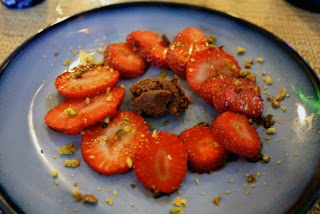In short, you saute some onion, carrot, and garlic in a little olive oil and butter, add a little wine, then chickpeas with stock and tomato paste. You let it hang out a little all together for a while, then season with some paprika or other red pepper, finish with a little lemon and parmesan, and that's it. Serve with some grain - couscous, orzo, and quinoa are some of my favorites - and something green, and you've got dinner.
 This is obviously just a template. In its simplicity, this dish also contains another virtue: it invites additions and modifications. Here are just a few ideas:
This is obviously just a template. In its simplicity, this dish also contains another virtue: it invites additions and modifications. Here are just a few ideas:Little bits of meat, whether leftover chicken or some chopped up bacon or pancetta, would be right at home here.
Mushrooms would also be a decidedly delicious addition.
Add a Parmesan rind with your stock to make a richer and more luscious dish.
Onions, carrot, and garlic usually form the base of this dish for me, but there are plenty of other options. Shallots, celery, bell peppers, and leeks come to mind... Or even some chopped olives...
For the pepper, paprika is the default, but you can switch it up: try Turkish Aleppo pepper, or smoked paprika, or try stirring in some Harissa (a Morrocan chili paste).
Options abound...
A quick note about two of the main elements of this dish: the chickpeas and the stock.
I highly recommend using dried chickpeas that you cook yourself. Like with most canned beans, canned chickpeas are too mushy for my taste. You can get more toothsome chickpeas by cooking them at home and pulling them off when there's just the right texture. You can also make them extra delicious by cooking them with a piece of kombu.
As for the stock, sorry vegetarians - chicken is really where it's at. Of course a good vegetable stock will work wonderfully too; the best, as with the chickpeas, is to make it yourself, whether it be meat of plant based.
One last thing: I say to finish this dish with some lemon juice; if you don't have any on hand, use a splash of red wine or sherry vinegar instead, but don't omit this acidic touch, or the dish will likely seem a little flat...

Simplest Chickpea Stew
Chop up an onion and a couple carrots, and heat a little olive oil and butter in a deep skillet. Cook onion and carrot over medium heat for 5 minutes.
Add a few minced cloves of garlic (I use about 7 or 8), cook for a couple more minutes.
Turn up the heat to fairly high, and when heated up add a generous splash of wine (any color will work well, but I prefer white here).
After a minute or so, add a couple cups of stock and couple tablespoons of tomato paste.
Stir to dissolve, then add 3 cups cooked chickpeas.
Cook for 15-20 minutes, until sauce has reduced and thickened to your liking.
Add paprika or other red pepper to taste (sorry, can't be much more precise here since peppers vary so wildly in heat and intensity. For mild paprika, you'll probably want about 2-3 tsp.). Add fresh herbs (thyme and oregano are great) if using. A splash of soy sauce can be really nice here too, especially if you're not using a meat stock.
Let it all get acquainted for a couple minutes, then turn off the heat and stir in 1 tbsp. or so of lemon juice.
Top with a little parmesan when serving.

















 me roasted almonds with pimentón, and carrots marinated in olive oil, sherry and garlic. There were little crostinis: one with a generously-herbed feta and another, reminiscent of a sping picnic in the French countryside, with butter, radishes, coarse salt, and a little leaf of fresh oregano. Lastly, there was the new house favorite: kale chips. These are pieces of kale tossed with olive oil, cider vinegar, and salt, and baked until perfectly crispy. The effect is odd, tantalizing, and addictive: a shattering crisp rapidly gives way to a melting texture, while the flavor is salty, a little sour, and wonderfully vegetal.
me roasted almonds with pimentón, and carrots marinated in olive oil, sherry and garlic. There were little crostinis: one with a generously-herbed feta and another, reminiscent of a sping picnic in the French countryside, with butter, radishes, coarse salt, and a little leaf of fresh oregano. Lastly, there was the new house favorite: kale chips. These are pieces of kale tossed with olive oil, cider vinegar, and salt, and baked until perfectly crispy. The effect is odd, tantalizing, and addictive: a shattering crisp rapidly gives way to a melting texture, while the flavor is salty, a little sour, and wonderfully vegetal.














